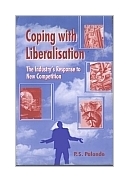|
||
• wydawnictwa polskie
• Zamów informacje o nowościach z wybranego tematu • kontakt
• Cookies na stronie |
COPING WITH LIBERALISATION.THE INDUSTRY'S RESPONSE TO NEW COMPETITION.PALANDE P.S.wydawnictwo: RESPONSE BOOKS , rok wydania 2000, wydanie Icena netto: With the initiation of economic liberalisation in the early nineties, India's industrial sector has been called upon to perform a crucial developmental role for the continued success of the ongoing structural adjustment programme. This book examines Indian industry's response to and strategy for coping with the far-reaching economic reforms and changes in industrial policy. It discusses how industry has braced itself to face the challenges of both domestic and external competition. Beginning with an historical overview of structural reforms, Dr Palande describes the strategies adopted by Indian enterprises in the new environment. These include measures such as organisational restructuring, adoption of new marketing strategies, entering into joint ventures and strategic alliances, focusing on core competencies, and rightsizing. The author also devotes separate chapters to discuss the implications of these changes for the public sector and the imperatives for government action, including the need to further dismantle growth-retarding restrictions on industry. The book concludes with a discussion on how the momentum of growth, which seems to have slowed down, can be regained and how the gains so far made can be consolidated by further reforms. This immensely readable book will be invaluable to industrialists, CEOs, senior executives and policy planners. It will also serve as a useful reference for courses in economics and business management. Contents Preface Acknowledgements
377 PAGES Księgarnia nie działa. Nie odpowiadamy na pytania i nie realizujemy zamówien. Do odwolania !. |


